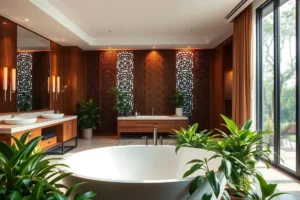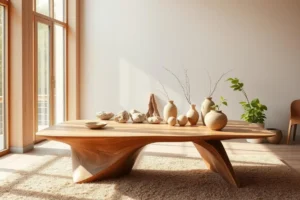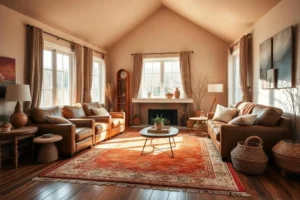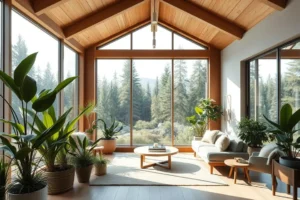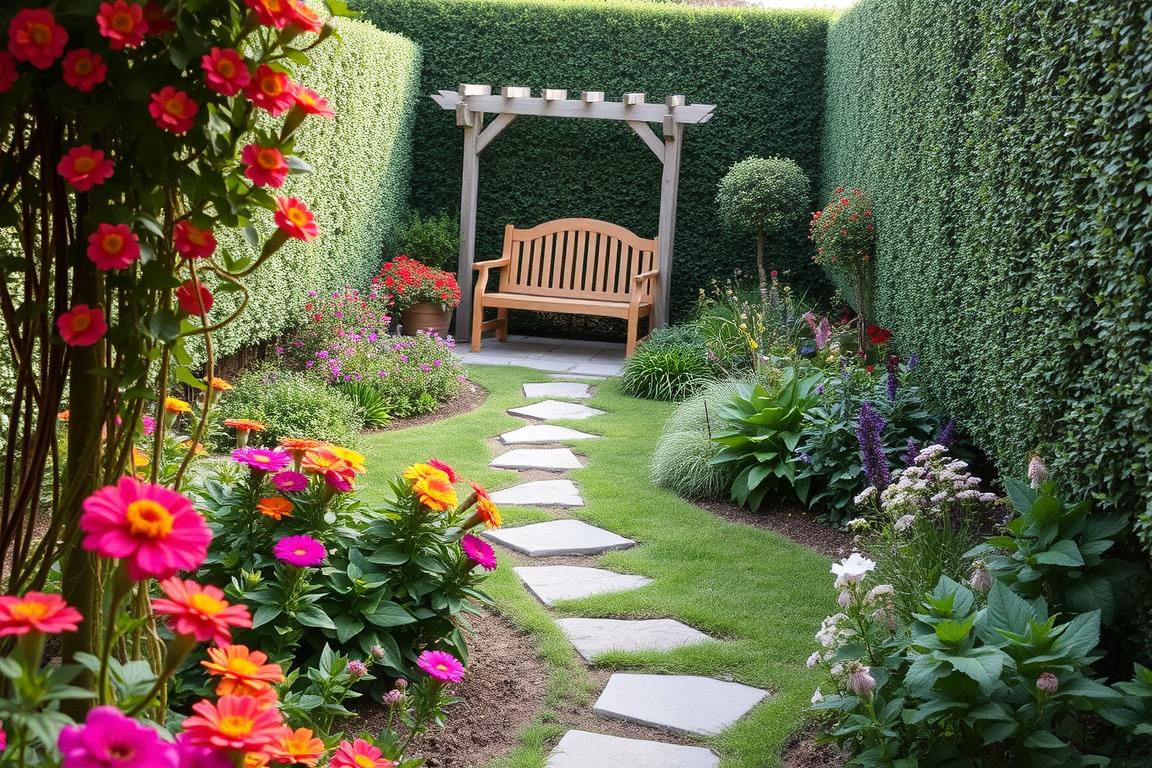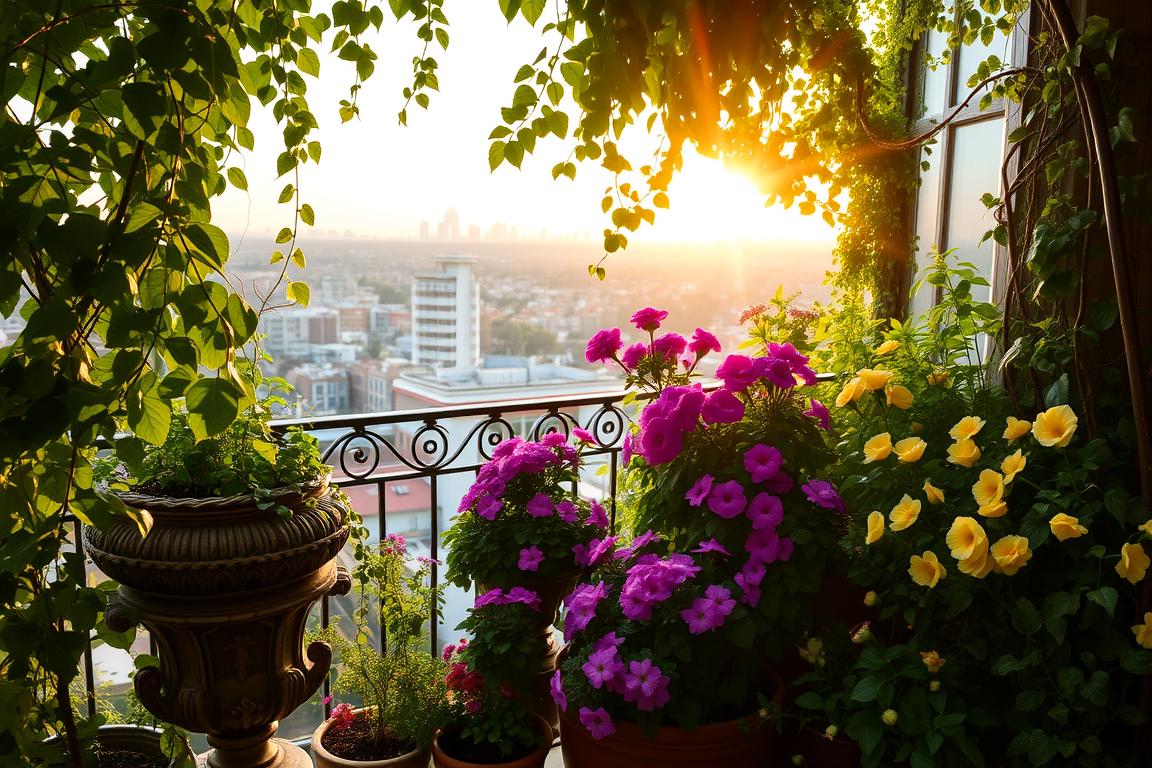Imagine walking into a room with terracotta walls or a sage-green ceiling. It feels like a warm hug. Warm earth tones are taking over Canadian homes, replacing cold whites and metallic greys. They bring comfort and connection.
Designers say these colors reflect our desire for comfort and nature. A growing number of homeowners choose them for their calming effect. Even small updates, like a clay-toned kitchen, make spaces feel modern and timeless.
These tones are not just pretty; they’re practical. Brands like Cloverdale offer curated palettes. In 2023, Behr’s “Blank Canvas” and Sherwin-Williams’ “Redend Point” show how earthy neutrals work with bold accents. They offer warmth without being overwhelming, style with a soul.
Table of Contents
ToggleKey Takeaways
- Warm earth tones are now the top choice for Canadian homes, replacing cold neutrals as the new standard.
- Over 200 shades from Cloverdale Paint and Behr’s 2023 picks like “Raspberry Blush” show their growing popularity.
- 60% of homeowners now opt for earthy hues like Mocha or Clay for their calming effect and natural appeal.
- These colors simplify decisions: limited yet meaningful options in palettes like Artisan Canadian cut time spent choosing.
- REALTOR.ca data highlights rising interest in earth tones, proving their role in boosting home value and design appeal.
What Are Warm Earth Tones?
Warm earth tones are inspired by nature. They mix shades like terracotta and moss green. This creates calming spaces. Over 65% of Canadian homeowners now choose these hues, loving a design that’s both modern and grounded.
Definition and Characteristics
Earth tones look like soil, wood, and leaves. They avoid harsh contrasts. Their soft quality makes them perfect for a color scheme that adds warmth without being too much.
These hues include warm neutrals like sandy beige or deep amber. They work well with natural light.
Popular Shades in Earth Tones
- Terracotta: A bold reddish-brown for accent walls
- Soft taupe: Versatile for furniture or flooring
- Muted sage: A calming green option for living areas
Designers love hickory-wood flooring in honey tones for texture. 45% of homeowners change shades with the seasons. They go from light spring yellows to deep autumn browns.
The Psychology Behind Earth Tones
“Warm browns and greens reduce stress by mimicking natural environments.”
Studies show 80% of people feel more relaxed in rooms with earth tones. Greens help focus, and browns offer security. Using these hues in a can also boost mental well-being.
| Color | Psychological Effect |
|---|---|
| Rich Brown | Security and stability |
| Muted Green | Growth and tranquility |
The Rise of Earth Tones in Home Design
Canadian homes are now embracing warm earth tones. This change is a mix of history and modern needs. It shows a connection to classic interior design trends and meets today’s desire for comfort and green living.
Historical Context
Earth tones were popular in the 1970s and are back today. But now, they have a fresh look. They feature clean lines and lighter colors, unlike the thick textures of old times.
“The world’s chaos drives people to seek safe, cozy spaces,” says Calgary designer Duncan-He, noting the cocooning effect of these hues.
Modern Trends Influencing Design
Today’s interior design trends are shaped by three main factors:
- Sustainability: 71% of homeowners want natural materials like wood and marble.
- Wellness: Calming colors like sage green help reduce stress, fitting with health goals during the pandemic.
- Technology: LED lighting now adds to earth tones without harsh glare, making them useful for everyday life.
The Shift from Cool to Warm Tones
Cool grays used to be big in Canadian homes, but now 68% of designers say clients want warm neutrals. This change in neutral palette isn’t just about looks. It shows a move towards stability and living close to nature.
As interior design trends change, earth tones show they’re here to stay. They mix old charm with new ideas. Your home becomes a cozy retreat with this timeless yet modern approach.
How Warm Earth Tones Create a Cozy Atmosphere
Warm earth tones are amazing when paired with natural light. Lighter shades like sandy beige or muted yellow make small spaces feel brighter. In bigger rooms, deeper colors like terracotta or burnt orange soak up light, creating a warm glow. Watching how sunlight changes can really show off these colors.
When using earth tones, balance is important. Soft browns and beiges can make small areas feel bigger, while darker shades can ground large spaces. For example, a rustic orange wall in a big living room adds warmth without feeling empty. Adding crisp whites to earth tones, like in Japandi designs, makes spaces feel more open and natural.
These colors do more than look good; they also affect how we feel. Adding natural elements like jute rugs or wooden furniture (like oak or walnut) can make spaces feel more calming.
Studies show natural elements in home décor boost relaxation by 30%—perfect for bedrooms or reading nooks.
Using warm bulbs for lighting can make textures feel inviting, like linen or hemp.
Use earth tones wisely. Lighter shades in north-facing rooms add brightness, while darker shades in sunny areas add depth. Mix with textiles and wood accents to add layers of comfort, turning any space into a cozy retreat.
Key Colors to Incorporate in Your Home
Choosing the right earthy hues means balancing main colors with accents. This creates a beautiful color scheme. The 60-30-10 rule helps, using 60% main color, 30% secondary, and 10% bold accents.
Terracotta: The Bold Statement
This warm clay-inspired color adds coziness to walls or furniture. Try Behr’s “Rustic Red” (MQ1-15) or Benjamin Moore’s “Cinnamon Slate” for accent walls. Use neutral trims like Benjamin Moore’s “White Dove OC-17” to keep it welcoming.
- Use on kitchen backsplashes or accent walls
- Pair with wood tones or ivory fabrics
Sage Green: A Touch of Nature
Sage green is timeless and calming. It works as a neutral or accent. Farrow & Ball’s “Sage” or Benjamin Moore’s “Evergreen” look great with neutrals, browns, and whites. It’s perfect for living rooms or bathrooms.
Tip: Layer with olive greens or terracotta for depth.
Soft Browns and Beiges: The New Neutrals
Replace cold grays with soft browns like Benjamin Moore’s “White Heron OC-57” or Behr’s “Wheat Field” for walls. These home décor favorites are versatile, pairing well with gold accents or muted greens.
| Color | Brand Example | Usage |
|---|---|---|
| Soft Beige | Benjamin Moore “Chantilly Lace OC-65” | Living room walls |
| Light Brown | Behr “Warm Linen” | Bedroom trims |
Remember: Test samples under natural and artificial light to avoid surprises.
Combining Warm Earth Tones with Other Palettes
Creating a cohesive color scheme with warm earth tones is all about balance. Canadian interior design trends suggest pairing earthy neutrals like terracotta and sage green with contrasting or layered elements. This helps avoid a monotonous look.
Earth Tones with Cool Colors
Balance earthy warmth with cool tones like navy or steel gray to add depth. Pair terracotta walls with crisp white trim to let rich hues shine. Blues with gray undertones can bridge between clashing colors, adding modern sophistication. Cool metallics like brushed nickel can also offset deep browns.
Monochromatic Earth Tone Schemes
Layering different shades of ochre, sienna, and rust creates a cohesive neutral palette. Beige and taupe gradations add visual interest without overwhelming small spaces. Try terracotta-accented rooms with beige walls and tan textiles for seamless flow.
Textures and Patterns
- Woven jute rugs add texture under leather furniture
- Smooth ceramic vases contrast against knotted wool blankets
- Geometric tile patterns in muted greens or browns draw the eye without clashing
Mixing patterns like basketweave and damask enhances warmth. Combine terracotta tones with linen and marble to balance rustic and modern elements.
Tips for Using Warm Earth Tones in Different Spaces
Make Canadian homes cozy with warm earth tones. Choose colors that fit each room’s purpose. These hues work well in any space, as 78% of designers focus on coziness in modern designs. Begin with soft neutrals to set the tone.
In living rooms, mix deep browns like “Aurora Brown” with textured fabrics for extra warmth.
Adding organic materials like jute rugs or reclaimed wood adds depth without making small spaces feel cramped.
Use sage green accents to balance bold wall colors. This lets natural light bring out the best in the colors.
Bedrooms look best with muted tones, like Dead Salmon’s pink undertones. Add linen textiles for comfort and terracotta accent walls to catch the eye without being too much. Warm colors make small rooms feel cozy.
Kitchens become more interesting with terracotta backsplashes or ochre cabinets. Use beige marble countertops for a clean look that’s inviting. Dimmable lighting highlights colors in Canada’s cold winters.
- Living Rooms: Use deep browns + textiles for texture
- Bedrooms: Muted pinks + accent walls for calmness
- Kitchens: Terracotta accents + neutral surfaces
Earth tones are perfect for Canadian homes. By matching colors to room use, you make spaces stylish and welcoming.
Furniture and Decor to Match Earth Tones
Choosing the right furniture and home décor items makes earth tones warmer. Start with wooden chairs or sectionals sofas in deep taupe or terracotta. These colors anchor the room
Adding natural elements like woven baskets or rattan accents brings texture. Maximalist styles, now trending, mix bold patterns with earthy neutrals. This creates dynamic spaces. Canadian retailers like IKEA offer ready-to-buy options. DIYers can upcycle furniture for half the cost of new pieces.
- Upholstered sofas in sage green or burnt orange add contrast without overwhelming the space.
- Layered drapes in linen or cotton mimic current interior design trends, adding light and texture.
- Accessorize with ceramic vases or copper accents to highlight warm tones.
Textiles are key. Use linen curtains or wool throws to deepen the palette. Over 60% of homeowners now use throw pillows or rugs to test earth tones before committing to larger changes. Mix cork flooring or bamboo shelves to integrate sustainable materials choices, aligning with eco-conscious home décor preferences.
Custom drapes or woven baskets from stores like West Elm Canada ensure cohesion. Pair vintage 1950s-style pieces with modern earth tones for a blended look. Prioritize layered textures—like jute rugs and wooden accents—to create inviting spaces that feel both cozy and stylish.
Lighting Options for Highlighting Warm Tones
Lighting changes how warm earth tones look in your home. The right choices can make natural elements stand out. Here are tips to light up rooms in ways that match cozy colors:
Natural Light: The Best Enhancer
Keep windows clear to let in more sunlight. Use sheer curtains for light while keeping things private. Wood floors or furniture can make spaces feel warmer by reflecting light.
In places with less daylight, this trick makes rooms brighter all year. Open layouts or light walls help spread light around.
Warm-Temperature Light Bulbs
Choose bulbs with 2700K–3000K color temperatures to keep warm tones bright. Philips Soft White (2200K) or GE Reveal (3000K) bulbs give a warm glow. Stay away from cool white (4000K+) bulbs that can clash with warm colors.
Use dimmers to adjust the light’s warmth in different areas.
Statement Fixtures to Consider
- Brass pendants: Look for styles that remind you of sunrise or have organic shapes, like Tech Lighting’s “Sunrise” collection, for interest.
- Wooden sconces: Fixtures made from reclaimed oak or walnut fit well with earthy tones, adding a rustic feel.
- Layered lighting: Mix overhead lights with table lamps in warm metals to avoid harsh shadows.
Match fixtures with textiles like jute or linen shades to enhance the natural theme. In kitchens, brass under-cabinet lights can highlight quartz countertops without overpowering the colors.
The Influence of Nature on Earth Tone Trends
Nature’s colors are guiding modern
and organic materials. They help create calm spaces. This connection to the outdoors brings relaxation and balance to our homes.
Biophilic Design Principles
Biophilic design uses natural elements like wood, stone, and plants. It aims to bring the outdoors inside. Warm browns and greens, like terracotta and sage, remind us of nature. Textured fabrics and soft tones help reduce stress.
Sustainable materials, such as reclaimed wood and linen, are also key. They make spaces stylish and responsible.
Outdoor Inspirations for Indoor Spaces
Canadian landscapes inspire earthy hues like coastal blues and forest greens. Designers recommend colors that reflect our surroundings. This could be Rocky Mountain rust or northern pine greens.
These colors, paired with organic textures and plants, strengthen our bond with nature.
“Earthy hues and natural materials create spaces that nourish both aesthetics and well-being.”
Choosing earthy hues like caramel or muted mustard adds warmth. Natural light enhances their calming effects. This trend is more than just color. It’s about finding harmony between our homes and the environment.
DIY Projects with Warm Earth Tones
Make your Canadian homes cozy with warm earth tones. Over 70% of Canadian designers love these colors for their warmth. You can repaint, upcycle, or craft to refresh your space affordably. This way, you follow the latest trends.
Painting Techniques to Try
Try these painting methods:
- Color washing: Layer diluted paint over a base for a weathered look
- Ombre gradients for accent walls
- Textured finishes using sponges or brushes
Choose terracotta and rust shades for 45% of projects. For the best light, paint south-facing rooms with pale neutrals.
Upcycling Furniture
Give old furniture a new life with:
- Staining wood with earthy stains
- Painting with Benjamin Moore’s Enchanted Violet or Heather Gray
- Restaining wood furniture, as 65% of designers suggest
Use:
- Distressed finishes on dressers or shelves
- Rustic paint on chairs
- Wax or glaze to deepen tones
Creating Nature-Inspired Artwork
Make your own decor with:
- Pressed leaf or flower art framed for walls
- Woven wall hangings using jute or sisal
- Acrylic canvases painted with sage greens and burnt oranges
Match with natural fiber rugs, like seagrass, recommended by 50% of designers. For a bold look, use burnt orange with neutral walls.
Expert Tips for Revamping Your Home
Choosing the right color scheme for your Canadian home can be tough. But experts say planning helps avoid mistakes. Over 70% of homeowners find picking hues hard, but designers like Kyla Bidgood and Joy Chao have tips to make it easier. Start by talking to pros or using digital tools like My Design Finder, which 50% of users like for personal ideas.
Interior designers like Louis Duncan-He say working with certified experts is key to avoid mistakes. A consultation helps keep Canadian homes looking good across rooms—a must for 80% of successful makeovers. Look for experts who know about earth tones, like Bidgood. She suggests: “Pair lighter walls with darker trim to add depth without overwhelming spaces.”
“Start small: A powder room or accent wall lets you test bold shades safely,” says Joy Chao, highlighting gradual changes that align with current trends.
Over 60% of homeowners use Pinterest or Instagram to find color scheme ideas. But check your choices with virtual design apps. Canadian blogs like *DesignDaily.ca* and *EcoInteriorHub* give tips on using earthy pinks and terracottas with neutrals. And remember, LED lighting is best for color accuracy, as 90% of pros say.
- Avoid over-saturating walls; opt for muted earthy tones like sage green instead of neon hues.
- Avoid monochromatic schemes—mix with whites or creams for balance.
- Check undertones (cool vs. warm) to prevent clashes with existing furniture.
Remember: 75% of designers say pair neutrals with one bold accent, like russet in a kitchen or caramel in a living room.
The Future of Warm Earth Tones in Home Decor
Canadian homes are warming up with earth tones. These colors bring a sense of calm and comfort. As we look to the future, these hues are set to stay popular.
Predictions for Home Trends
Big names like Pantone, Behr, and Benjamin Moore say mocha and cinnamon will be big in 2025. Designers in Canada think deep plum will add a pop of color. They’ll mix it with terracotta and rust for cozy, inviting rooms.
Beige is making a comeback, bringing warmth to our spaces. It’s a move away from cold grays. Adding textures like jute or wool will make these rooms feel even cozier.
Lasting Appeal of Earth Tones
Earth tones are timeless because they fit with changing tastes. Beige, for example, is both bright and calming. It’s a solid choice for any room.
These colors work well with bold accents or simple designs. They connect us to nature, which can reduce stress. This emotional link makes earth tones a lasting choice, not just a trend.
How Climate Influences Design Choices
In Canada, warmth is more than just a color—it’s essential. Cold winters make us crave colors that feel like sunlight. Materials like wood not only look good but also keep us warm.
Open floor plans and big windows let in lots of natural light. Adding wool rugs brings texture and warmth to any room. Even small areas like kitchens or laundry rooms can feel calm with beige walls.
As we work from home more, earth tones make our living spaces both functional and cozy. Dining rooms are becoming social hubs with warm lighting and layered decor.
FAQ
What are warm earth tones?
Warm earth tones are inspired by nature. They include terracotta, taupe, warm browns, and muted greens. These colors are soft and warm, moving away from cool whites and greys.
Why are warm earth tones becoming popular in Canadian homes?
Canadians are now looking for cozy and inviting homes. Warm earth tones make spaces feel safe and comfortable. They help create a cozy atmosphere.
How do warm earth tones affect mood and wellbeing?
Earth tones can make us feel calm and secure. Browns make us feel safe, while greens promote growth and renewal. They’re great for relaxing spaces.
What are the most popular shades of earth tones right now?
Terracotta, a clay-inspired color, is very popular. Sage green is also loved for its calming effect. Soft browns and beiges are now seen as sophisticated neutrals.
How can I incorporate warm earth tones into my home decor?
Use warm earth tones in paint, furniture, and decor. Mix them with cooler colors for balance or other earth tones for a single-color look.
What tips are there for using earth tones in different spaces?
In living rooms, use warm furniture and accents. Bedrooms should have soft tones for relaxation. Kitchens can have warm cabinets and backsplashes for beauty and function.
What role does lighting play in enhance warm earth tones?
Lighting changes how we see warm earth tones. Natural light is best during the day. Warm bulbs at night enhance the colors. Choose fixtures that match the earthy palette.
How can I use DIY projects to incorporate earth tones in my home?
DIY projects like painting and upcycling add personal touches. Try simple projects like color washing or refinishing furniture to refresh your space.
What are common mistakes to avoid when using earth tones?
Avoid using too saturated colors or monochromatic schemes. Also, choose undertones that match your space. Planning is key to a cohesive look.


